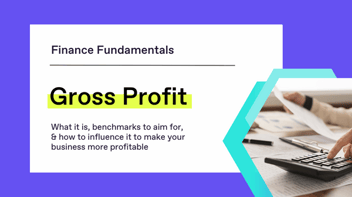A Simple Guide to Contribution Margin
What is Contribution Margin?
Contribution margin is an accounting calculation that tells you how a particular product contributes to the overall profit of a business. It’s measured by the money left over from sales revenue after paying all variable expenses associated with producing a product.
The “contribution” part represents the share of sales revenue not consumed by variable expenses, and so contributes to the portion of fixed costs.
The variable expenses are known as your variable cost of goods sold (COGS). Variable COGS are those that fluctuate depending on how much of the product (the volume of goods) you sell. These are cost like raw materials, freight charges, and potentially delivery costs.
IN THIS ARTICLE
→ Understanding Contribution Margin
→ How to Calculate Contribution Margin
→ Formula for Contribution Margin & Contribution Margin Ratio
→ Contribution Margin Explained Simply
→ Types of Variable Expenses in Buy-and-Sell & Manufacturing Businesses
→ Why Variable Costs Matter
→ Contribution Margin Benchmarks
→ Factors that Influence Contribution Margin
→ What You Need to Know If You Have Subcontractor in Your Business
Understanding Contribution Margin
EXECUTIVE SUMMARY
- The contribution margin is your revenue minus your variable expenses.
- Contribution margin is important because it reflects how cost fluctuations can impact profitability.
- To calculate contribution margin, take your revenue and subtract your variable COGS.
- To calculate contribution margin percentage (or ratio), take your contribution margin dollar value and divide it by your revenue.
- Most businesses, including manufacturing, should aim for a contribution margin KPI of 60% or above.
- Factors that influence contribution margin include selling price, product mix, sales volume, waste, purchase prices, and foreign exchange rates. It’s crucial to consistently apply and calculate these numbers for accurate results.
How to Calculate Contribution Margin
The contribution margin formula is your revenue minus your variable cost of goods sold (COGS), which is expressed as a dollar figure.
Formula for Contribution Margin
To work out your contribution margin, simply subtract your variable COGS from your revenue.
.png?width=760&height=200&name=Formula%20-%20Contribution%20Margin%20($).png)
Formula for Contribution Margin Percentage
To calculate contribution margin percentage (%), also known as contribution margin ratio, your contribution margin dollar value is divided by your revenue.
.png?width=760&height=200&name=Formula%20-%20Contribution%20Margin%20Percentage%20(%25).png)
Contribution Margin Explained Simply
Jump to video (above) here
Contribution margin is your revenue minus your variable cost of goods sold.
Your contribution margin percentage is your contribution margin dollar value divided by your revenue.
What does this mean? When you look at your variable cost of goods sold, these are the items that should move up or down depending on how much or how little revenue your business does.
So for example, if you are selling Coke bottles, your variable cost of goods sold would be the cost of the Coke bottle. If you sell a hundred, it’ll be the cost of the a hundred. If you sell a million like a supermarket, it’ll be the cost of the million. There’s a direct correlation between how much you sell and then how much you consume of that item.
→ Related: Contribution Margin & Gross Profit Explained
Types of Variable Expenses in Buy-and-Sell & Manufacturing Businesses
In a buy-and-sell or merchant business, examples of variable costs of goods sold are purchases, the freight to get them into your possession, and then potentially the freight to deliver them to the client (if that is necessary).
It’s also similar in a manufacturing business - it’s the raw materials you use, the freight used to get the product into your possession, and then the freight to deliver it to your client.
Why Variable Costs Matter
Those are the main examples of variable cost of goods sold. Why is this important? It’s important to understand how much the cost of those direct inputs that vary change over time. If, for example, you increase your price, if your supplier costs go up, that’s going to impact what your contribution margin is. Also, if there’s a change in your product mix, some product mixes will get a better contribution margin than others.
Contribution Margin Benchmarks
What should we be aiming for with contribution margin? In a manufacturing business, we say around about 60% and above is where we want to be. Once you’re above 60% in a contribution margin for a manufacturing business, you start to do very well.
In a buy-and-sell or a merchant style business, you’d probably aim for a slightly lower contribution margin than in a manufacturing business because you are buying products that are finished goods as opposed to raw materials that haven’t yet been converted into a finished product.
Factors that Influence Contribution Margin
The things that influence contribution margin are firstly your selling price, the product mix of what you are selling, as well as the volume of what you’re selling.
I mentioned Coca-Cola bottles earlier. If you are the corner shop selling Coca-Cola versus the big supermarket, clearly the big supermarket is going to get a better buying price because of the volume that they purchase.
The other side of the equation is the variable cost of goods sold side. So that can be impacted again by your product mix. It can be impacted by how much waste there is, how much spoilage there is. Also depending on how good your purchase prices are, if you can purchase from a cheaper supplier but still have the same quality, that’s clearly going to help you with your contribution margin.
Lastly, foreign exchange values can also have an effect. If you are importing product from overseas and the foreign exchange rate changes either for you or against you, that’s going to impact your contribution margin as well.
What You Need to Know if You Hire Subcontractors
One last item on contribution margin is there could be items that are variable costs of goods sold depending on your business, that wouldn’t necessarily be for another business. An example might be a subcontractor. If you are running a construction business and you are using subcontractors, they will go up or down depending on how much you are building. Whereas in another business you might use a subcontractor and that’s actually a fixed ongoing cost as well.
The key point with any of these KPIs is making sure you are consistent in your application and calculation of these numbers.
Learn everything we teach our clients... for free
Join 400+ business owners & leaders who receive practical business & accounting tips, delivered free to your inbox every week. No fluff, just high-level expertise. Sign up now.


.png?width=352&name=Yellow%20Black%20Modern%20Course%20YouTube%20Thumbnail%20(35).png)

